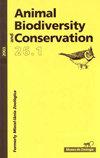沿墨西哥湾北部和美国东南大西洋沿岸的帽头鱼(Sphyrna tiburo)的饮食
IF 1
4区 环境科学与生态学
Q3 BIODIVERSITY CONSERVATION
引用次数: 1
摘要
在美国东南部海岸的西大西洋,研究了一种潜在的杂食性沿海鲨鱼物种bonnethead(Sphyrna tiburo)的饮食。使用标准化胃内容物分析方法对从德克萨斯州、阿拉巴马州、佛罗里达州和南卡罗来纳州收集的423个胃进行了分析。在所分析的地理范围内,饮食以螃蟹为主,主要是梭子蟹(Callinetes spp.),尽管螃蟹的相对重要性因地区而异。在整个研究区域,没有观察到饮食的个体遗传变化。南卡罗来纳州的雌蟹和雄蟹表现出不同的饮食,尤其是梭子蟹的摄入量,雌蟹的摄入量比例更高。除南卡罗来纳州外,所有地区的白头翁都食用了有限数量的海草,在那里,白头翁在沼泽为主的海湾和河口占据了没有海草的栖息地。这一发现表明,至少在季节性的情况下,海草并不是这种鲨鱼饮食的重要组成部分,可能只会在意外摄入时出现在胃里。本文章由计算机程序翻译,如有差异,请以英文原文为准。
Diet of the bonnethead (Sphyrna tiburo) along the northern Gulf of Mexico and southeastern Atlantic coast of the United States
The diet of a potentially omnivorous coastal shark species, the bonnethead (Sphyrna tiburo), was examined in the western Atlantic along the coast of the southeastern United States. A total of 423 stomachs collected from Texas, Alabama, Florida and South Carolina were analyzed using standardized stomach content analysis methods. The diet was dominated by crabs, primarily portunids (Callinectes spp.), across the geographical range analyzed, though the relative importance of crabs varied between regions. Ontogenetic shifts in diet were not observed throughout the region studied. Female and male bonnetheads in South Carolina displayed different diets, particularly in the amount of portunid crabs consumed, with a higher proportion ingested by females. Bonnetheads consumed limited amounts of seagrasses in all regions except in South Carolina, where they occupy habitats without seagrasses in marsh dominated bays and estuaries. This finding indicates that, at least seasonally, seagrasses are not an essential part of the diet of this shark species and may only occur in stomachs as accidental ingestion.
求助全文
通过发布文献求助,成功后即可免费获取论文全文。
去求助
来源期刊

Animal Biodiversity and Conservation
农林科学-动物学
CiteScore
2.00
自引率
0.00%
发文量
21
审稿时长
>12 weeks
期刊介绍:
Animal Biodiversity and Conservation (antes Miscel·lània Zoològica) es una revista interdisciplinar, publicada desde 1958 por el Museu de Ciències Naturals de Barcelona. Incluye artículos de investigación empírica y teórica en todas las áreas de la zoología (sistemática, taxonomía, morfología, biogeografía, ecología, etología, fisiología y genética) procedentes de todas las regiones del mundo. La revista presta especial interés a los estudios que planteen un problema nuevo o introduzcan un tema nuevo, con hipòtesis y prediccions claras, y a los trabajos que de una manera u otra tengan relevancia en la biología de la conservación. No se publicaran artículos puramente descriptivos, o artículos faunísticos o corológicos en los que se describa la distribución en el espacio o en el tiempo de los organismes zoológicos.
 求助内容:
求助内容: 应助结果提醒方式:
应助结果提醒方式:


